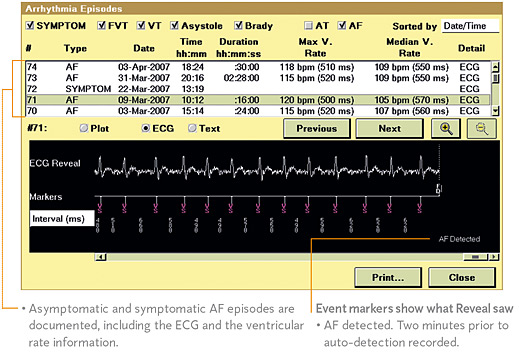
 |
 |
| ||||||||||||||||||||||||||||||||||||
|
Mark: patient case Long-term monitoring, real-time data
| ||||||||||||||||||||||||||||||||||||
| Physical examination -> | hypertension (160/95 mmHg). |
| ECG -> | normal sinus rhythm, 90 bpm. |
| Echocardiography -> | normal LV function, mild mitral regurgitation. |
| Exercise test -> | hypertension at submaximal exercise level, no ischemia, severe dyspnea. |
| Successive ambulatory (24h) ECG recordings -> |
one AF episode (25 seconds asymptomatic); sinus tachycardia during dyspnea. |
| Conclusion -> | no documented relation between AF and symptoms. |
Is there a relation between the asymptomatic AF and the complaints of dyspnea?
Is there a need for anticoagulation?
Use of a beta-blocking agent.
Reveal XT was chosen to monitor for arrhythmias.
Reveal showed more conducted AF than expected.
Two months post-implant an AF burden (symptomatic and asymptomatic episodes) of more than 5 hours a day was found.
These were mostly episodes of 2 to 8 hours with episodes occasionally lasting 24 to 36 hours. The ventricular response rate sometimes exceeded 160 bpm during AF.
Complaints of palpitations were related both to AF episodes and on occasion these appeared to be related to ventricular extrasystoles. Dyspnea complaints were related to exercise in the presence of AF, when ventricular rates of more than 160 bpm were present.
Start anticoagulation, increase beta-blocking drug dose, start class Ic antiarrhythmic agent.
How Mark’s condition improved
In the following 6 months the dyspnea complaints gradually diminished. Only a few palpitation complaints remained and Reveal XT showed these to be related to ventricular extrasystoles. In addition, AF burden was reduced to less than 30 minutes a day.
